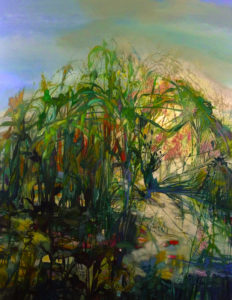
See Corrine Colarusso’s “Shaking the Twilight, Reeds Rain and Vapors” at the Georgia Museum of Art through Nov. 17.
The Georgia Museum of Art at the University of Georgia is currently displaying two large works by Georgia artist Corrine Colarusso in its permanent collection galleries.
“Stack of Twilight” and “Shaking the Twilight, Reeds Rain and Vapors” are on view through Nov. 17 in the museum’s Barbara and Sanford Orkin Gallery.
Colarusso received her undergraduate degree in painting from the University of Massachusetts and a Master of Fine Arts degree, also in painting, from the Tyler School of Art of Temple University in Philadelphia. She has received awards and grants including a Guggenheim Fellowship, a National Endowment for the Arts Grant and a Fulbright-Hayes research and travel grant to India and Nepal.
She has been a visiting artist at the American Academy in Rome, the Cortona Program of the University of Georgia and the Ossabaw Island Project, Ossabaw Island, Georgia.
She was a tenured associate professor of painting at the Atlanta College of Art from 1975-1996. Her work has been shown in many solo and group exhibitions and is included in numerous public, private and corporate collections.
Colarusso’s work is both figurative and abstract, focusing attention on the experience of looking and being present in the natural world.
“In my work, nature, landscape, the bright symbolic sunrise, the gloaming, weather conditions, paint and color become a stirred fiction,” Colarusso said.“There is a metaphorical, fugitive quality to my work. It depicts not a comfortable nature, but a shifting one, acknowledging that we live in a time when technology seems increasingly natural to us and nature itself less so. And because of this, landscape, nature, plant life, however beautiful and seemingly familiar, provide a speculative reality.”
Colarusso’s “Twilight” paintings make the viewer consider the passage of time and the human desire for light, especially as the days grow shorter. Using color and an intense concentration on the materiality of paint, they make viewers feel present in their natural spaces and aware of slow change. “They help us to appreciate that we are in a moving world in a grand universe,” Colarusso said.







